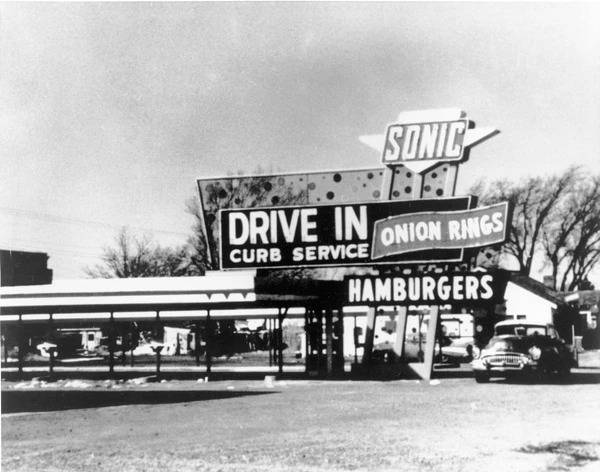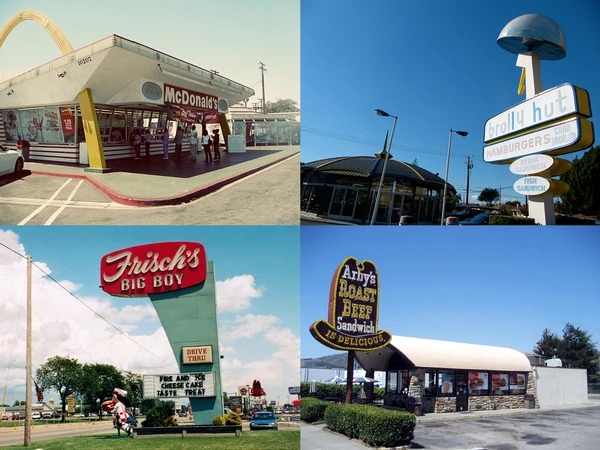On October 14, 1947, the skies above the Mojave Desert of Southern California cracked and boomed. Chuck Yeager, flying with two broken ribs in an experimental X-1 aircraft, became the first pilot to break the sound barrier.
He would continue to break speed records for the US Air Force: pushing the boundaries of will, technology, and almost certainly, sanity. As Yeager roared along above the Earth, at times tearing at the intangible fabric of sound itself, another revolution in speed was going on down below—at lunch time.


From a single gravel parking lot, the company has slowly built an empire out of the Midwest, with sales totaling over $500 million in revenue annually. And its roots are inextricably linked with the wonder and innovation of the Atomic Age—far beyond just its name.
Perhaps a Yeager in his own way, Smith saw a need to push the capabilities of speed both as a means of better serving customers and also efficiency. The key to both came in the form of a simple intercom system that allowed diners to order from their cars, eschewing the typical walk-up style of hamburger stand. By 1956, Top Hat’s business model, and a new slogan—”Service at the speed of sound”—had been born.
With the help of a new business partner, Charles Pappe, Top Hat expanded to four locations throughout Oklahoma. In 1959, the name was formally changed its name to Sonic, after Smith and Pappe discovered that the trademark for Top Hat had already been registered. The switch proved fortuitous, gelled effortlessly with their slogan, and fit in with Smith’s sharply honed business sense.
“Troy Smith quickly discovered that good food was not enough to win on the battleground of fast food,” Dr. Bob Blackburn, author of Sonic: America’s Drive-In, tells MUNCHIES. “To gain a strategic advantage, he used two-way speakers to order from a car and eliminated wasted motion inside a compact kitchen to deliver fresh-made food ‘with the speed of sound.’” Sonic also became known for its car-hops, who glided to cars on roller skates to deliver orders.
The lofty tenets that poured out of the Atomic Age converged, however quietly, into the drive-ins and fast food restaurants of the 50s and 60s. Hamburger stands and fast food restaurants popped up along highways, dotting a changing social and culinary landscape.

“Speed has always been a fascination of humans,” Alan Hess, an architect, author, and historian, tells MUNCHIES. “The very idea of fast food implies speed, which is what jet airplanes and rockets, and all those amazing race cars on the Bonneville Salt Flats in Utah represented. Speed was the key to the times.”
The concept itself wasn’t new: from fish-and-chip shops to food carts and diners in the late 19th and early parts of the 20th century, fast food had already been in existence, in some form, for years. It did, however, achieve a sort of cultural imprimatur in 1951, when the Merriam-Webster Dictionary included the term “fast food,” for the first time. But in the Atomic Age, fast food marked a deeper social significance than just being able to scarf down a meal between work shifts. “Fast food restaurants allowed the average person to participate in this amazing new world of modern technology,” says Hess.
The form and design of fast food restaurants often shared a special relationship with the growing attitude of scientific optimism through Googie architecture—a style now often maligned as gaudy and ridiculous. Buildings incorporated all manners of design forms that drew on speed and force: parabolas, starbursts, boomerangs, and columns. Rooftops would curve and shoot upward, away from the ground, seeming to defy gravity. The thrill in the raw power and technical perfection of rockets, jet engines, and atomic energy could be experienced at leisure.
The architecture also had more practical significance. “The shape of the building responded to the function,” says Hess. The giant, exaggerated roofs would peek out over other buildings, beckoning to drivers. Their signs, bursting up out of the ground, had to be tall and bold to attract customers passing by in their cars.
“It was no accident that Troy Smith and Charlie Pappe expanded Sonic at a time when speed, efficiency, and technology—the images of the Atomic Age—were reflected in the design of automobiles, the impact of television, and the aerodynamic shapes of spacecraft,” says Blackburn.
Even Sonic’s parking lot was specially designed. Eschewing normal side-by-side parallel parking, Smith implemented the now iconic off-set diagonal spaces—to prevent “wild teenagers” from being able to socialize with other cars.
As for the food: it was typically sandwiched between two buns, sometimes with cheese, sometimes without. The simplicity of the menu, like other burgeoning hamburger stands of the time, had a quality of almost mechanical precision.

In the years since, Sonic’s trajectory is unique, compared with some of its still remaining competitors from that era. While its menu isn’t as bare bones as In-N-Out Burger, its offerings are still built around the items popular 70 years go: burgers, hotdogs, fries, sodas, and milkshakes. That has undoubtedly become part of the restaurant’s appeal. The only experimental side of its menu is the beverage list.
“I think less is more, sometimes,” David Michaels, author of The World Is Your Burger: A Cultural History, tells MUNCHIES. “Burgers have become such an iconic lifestyle choice for most people. I think that [when it comes to the] menu, they want it simple. They want their fries, their drink, their milkshake, and that’s basically it.”
In recent years, the McDonalds of the 50s and 60s is barely recognizable, hidden behind lattes, “artisanal” burgers, kale salads, and touch screens. Burger King has shifted its focus to novelty items (lest we forget the Cheetos Chicken Fries).
Sonic, on the other hand, is almost an anachronism: ordering through a static-ridden speaker system is a novelty of a bygone era. Eating in our cars has become so commonplace that we have to consciously try not to do it.

The technical innovation of those early days in Shawnee has without a doubt been eclipsed by the chain’s ubiquitous brightly colored frozen drinks and quaint nostalgia. The crackle from the speakers is a reminder of the Atomic Age from where it was born, when the speed, efficiency, and technical accomplishment of delivering a hamburger hot and ready in a matter of minutes was no less revolutionary and iconic than Chuck Yeager’s flight above Rogers Dry Lake.
Though, you’ll never hear a short-order cook’s name spoken with the same reverence as a jet pilot’s.





